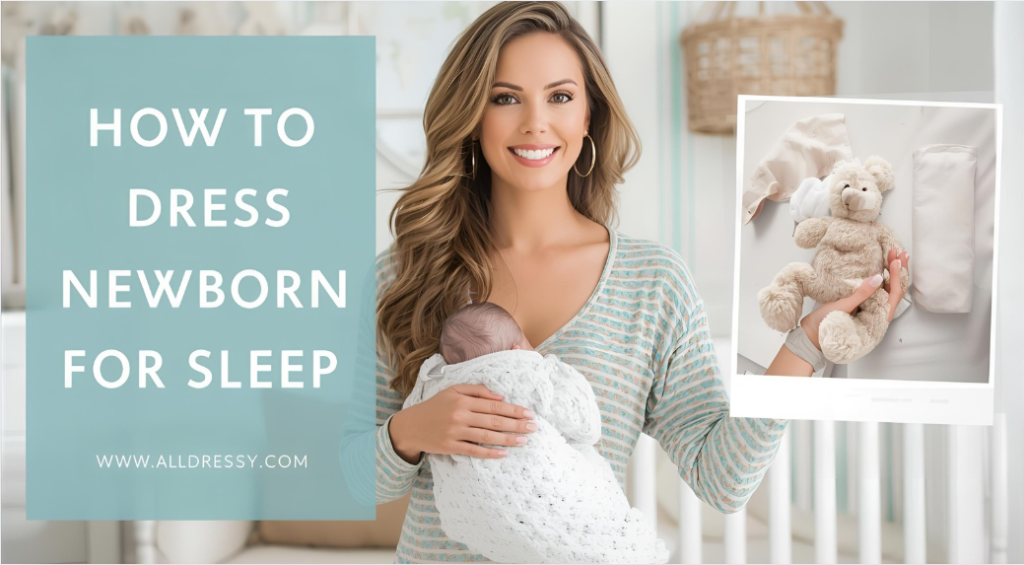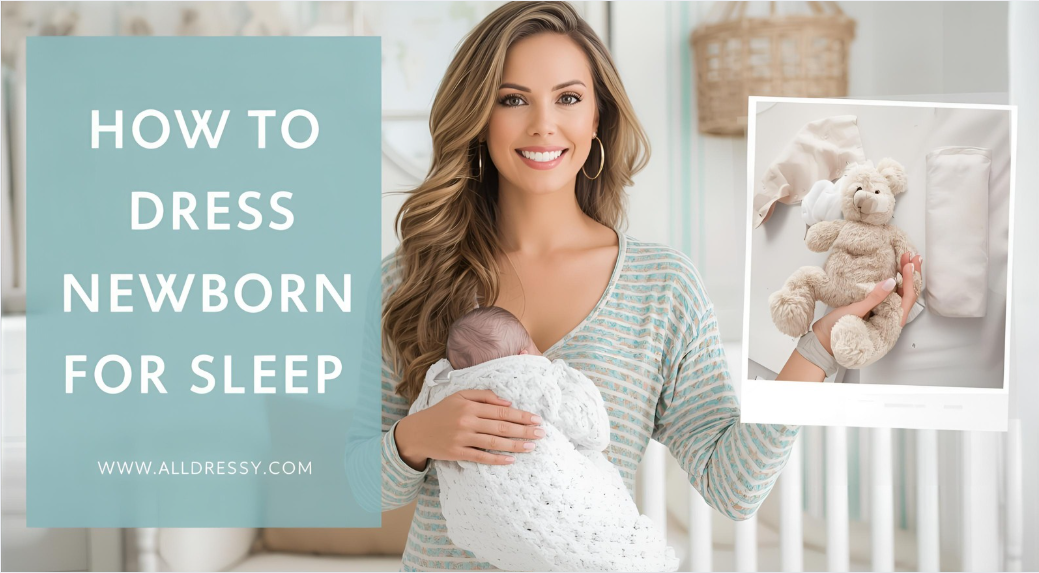Ensuring that your baby sleeps safely and comfortably is a top priority for new parents. One of the most crucial factors in creating a safe sleep environment is knowing how to dress newborn for sleep. Proper sleepwear can help regulate your baby’s body temperature, prevent overheating, and promote restful sleep, while also reducing the risk of sleep-related accidents like Sudden Infant Death Syndrome (SIDS).
Dressing a newborn for sleep involves understanding appropriate fabrics, layering, seasonal adjustments, and sleepwear types. This comprehensive guide will walk you through all aspects of dressing your baby for safe and comfortable sleep, from the basics of sleepwear to advanced tips for different seasons, so your little one can sleep soundly through the night.
Why Proper Sleepwear is Important for Newborns

Newborns cannot regulate their body temperature as effectively as adults. If they are too hot or too cold, it can disrupt their sleep, increase fussiness, and potentially pose health risks. Knowing how to dress newborn for sleep ensures that your baby remains at a comfortable temperature throughout the night.
- Temperature Regulation: The right sleepwear helps maintain the baby’s core temperature between 68–72°F (20–22°C), which is considered ideal for infant sleep.
- Safety: Appropriate clothing reduces the risk of overheating, suffocation, and entanglement.
- Comfort: Soft, breathable fabrics prevent skin irritation and promote better sleep quality.
Essential Factors When Choosing Sleepwear for Newborns
When selecting sleepwear, consider the following elements:
1. Fabric Choice
The fabric should be soft, breathable, and gentle on sensitive newborn skin.
- Cotton: The most popular choice; soft, breathable, and easy to wash.
- Bamboo: Hypoallergenic, moisture-wicking, and gentle on delicate skin.
- Fleece: Suitable for colder climates but should be lightweight to prevent overheating.
2. Fit and Comfort
Sleepwear should fit snugly without being restrictive. Loose clothing may bunch up and cover the baby’s face, while overly tight clothes can be uncomfortable and limit movement.
- Ensure armholes, legs, and neck openings are appropriately sized.
- Avoid sleepwear with large hoods or excess fabric that can pose suffocation risks.
3. Safety Standards
Look for certified sleepwear labeled as flame-resistant or snug-fitting, depending on your preference.
- Flame-Resistant: Provides safety against fire hazards.
- Snug-Fitting: Reduces suffocation risk and is often preferred for layering with blankets in modern safe sleep practices.
Types of Sleepwear for Newborns
There are several options when it comes to dressing your newborn for sleep.
1. Onesies and Bodysuits
- Ideal for year-round use, especially when layered.
- Snap closures allow easy diaper changes without fully undressing the baby.
2. Footed Pajamas
- Full-body pajamas that cover arms, legs, and feet.
- Provide warmth and prevent socks from slipping off during sleep.
3. Sleep Sacks or Wearable Blankets
- Alternative to loose blankets, especially recommended for newborns.
- Comes in lightweight or insulated versions, ideal for different temperatures.
- Reduces the risk of suffocation or SIDS associated with loose bedding.
4. Swaddles
- Helps newborns feel secure, mimicking the womb environment.
- Prevents startle reflexes from waking the baby.
- Should allow room for the hips to move freely to avoid hip dysplasia.
Layering Your Newborn for Sleep
Layering is key to ensuring your baby is neither too hot nor too cold. The general rule of thumb is to use one more layer than you would wear yourself to bed.
Tips for Layering:
- Start with a cotton onesie or bodysuit as the base layer.
- Add a footed pajama or sleep sack for warmth.
- Use lightweight blankets for additional comfort if needed, but always avoid loose bedding.
- Check the baby’s neck or back of the neck to gauge temperature; hands and feet may be cooler and are not accurate indicators.
Seasonal Guidelines: How to Dress Newborn for Sleep
Newborn sleepwear must be adapted based on the season to maintain the ideal body temperature.
Summer
- Lightweight cotton onesies or bodysuits are sufficient.
- Use a breathable, lightweight sleep sack if the room is cooler.
- Avoid heavy blankets and fleece pajamas to prevent overheating.
Winter
- Layer a long-sleeve onesie with a footed pajama.
- Opt for thicker sleep sacks or wearable blankets for added warmth.
- Ensure the room is heated appropriately and avoid heavy bedding that could smother the baby.
Spring and Fall
- Transitional weather requires light layering.
- Use a long-sleeve bodysuit with a lightweight footed pajama or sleep sack.
- Adjust layers based on room temperature, checking frequently for comfort.
Room Temperature and Sleepwear
Maintaining the nursery at an optimal temperature is crucial. Experts recommend a room temperature of 68–72°F (20–22°C) for safe sleep.
- If the room is cooler, add an extra layer like a footed pajama or sleep sack.
- If the room is warmer, keep the baby in a single cotton onesie.
- Avoid over-bundling, as overheating is a leading risk factor for SIDS.
Signs Your Newborn is Too Hot or Too Cold
Monitoring your baby’s temperature ensures safe and comfortable sleep.
- Too Hot: Sweaty skin, flushed face, rapid breathing.
- Too Cold: Cool chest or back, blue-tinged lips or extremities, restless movements.
- Adjust layers accordingly, always checking the baby’s back or chest for accurate temperature assessment.
Avoiding Unsafe Sleepwear Practices
Parents should be cautious to avoid sleepwear and practices that increase risk:
- Do not use loose blankets in the crib.
- Avoid hooded sleepwear that could cover the face.
- Skip clothes with drawstrings or loose ties that can pose a strangulation hazard.
- Ensure snaps, buttons, or zippers are secure and do not irritate the skin.
Swaddling Techniques for Safe Sleep
Swaddling can help newborns sleep more peacefully but must be done safely:
- Wrap snugly around the upper body, leaving room for the hips and legs to move freely.
- Use breathable materials to prevent overheating.
- Stop swaddling once the baby starts rolling over to avoid suffocation risk.
Choosing Sleepwear Based on Weight and Size
Newborns grow quickly, so it’s important to select sleepwear that fits well without being too tight:
- Consider buying sleepwear in slightly larger sizes to accommodate growth, but avoid excessively loose clothes.
- Check that footed pajamas or sleep sacks allow enough room for kicking and stretching.
- Adjustable sleep sacks with zippers or snaps can extend usability as your baby grows.
How to Layer with Accessories
Accessories should be minimal to avoid safety hazards:
- Avoid hats or mittens during sleep.
- Lightweight socks can be used if the baby’s feet are cold, but remove them if overheating is suspected.
- Avoid loose blankets or bumpers inside the crib.
Nighttime Routine and Sleepwear Tips
Consistency in sleepwear and routines can improve your baby’s sleep:
- Dress your newborn in the same type of sleepwear each night for a consistent routine.
- Change diapers right before sleep to avoid unnecessary disturbances.
- Keep the nursery dimly lit and maintain a calm environment.
- Monitor your baby’s temperature periodically during sleep, especially during temperature fluctuations.
Travel and Out-of-Home Sleepwear
When traveling or visiting relatives, maintaining proper sleepwear is equally important:
- Bring familiar sleep sacks or pajamas to ensure comfort.
- Maintain the same layering system used at home.
- Keep the sleeping environment cool, safe, and free of loose blankets.
Choosing the Right Sleepwear Brands
Not all sleepwear is created equal. Look for brands that prioritize safety, comfort, and durability:
- Certified flame-resistant sleepwear brands provide extra peace of mind.
- Organic cotton and bamboo options are ideal for sensitive skin.
- Adjustable sleep sacks with easy-access zippers or snaps simplify diaper changes at night.
Monitoring Your Baby During Sleep
Even with the perfect sleepwear, parents should remain vigilant:
- Use baby monitors to keep an eye on your newborn during naps or nighttime sleep.
- Check the baby’s back or chest for warmth rather than relying solely on hands and feet.
- Adjust sleepwear layers according to room temperature changes or seasonal shifts.
Tips for Ensuring Long-Term Comfort and Safety
- Rotate sleepwear regularly to accommodate growth and seasonal changes.
- Wash all sleepwear before first use to remove potential irritants.
- Keep the nursery environment consistent to promote better sleep patterns.
- Avoid overdressing even during cold months; safe layering is preferable to heavy clothing.
Frequently Asked Questions (FAQs)
1. What is the best fabric to dress a newborn for sleep?
Soft, breathable fabrics like cotton or bamboo are ideal. They are gentle on sensitive skin, wick away moisture, and help regulate body temperature. Fleece is suitable for colder climates but should be lightweight to prevent overheating.
2. Should newborns wear socks or hats during sleep?
Socks can be used if the baby’s feet are cold, but remove them if overheating is suspected. Hats are generally not recommended during sleep as they can cover the face and pose a suffocation risk.
3. What type of sleepwear is safest for newborns?
Footed pajamas, onesies, and sleep sacks or wearable blankets are safest. Avoid loose blankets, hooded sleepwear, or garments with drawstrings that could pose a risk of suffocation or strangulation.
4. How can I tell if my newborn is too hot or too cold?
Check the baby’s back or chest:
- Too hot: Sweaty skin, flushed face, rapid breathing.
- Too cold: Cool chest or back, blue-tinged lips or extremities, restless movements.
5. Can I use swaddles for newborn sleep?
Yes, swaddles can help newborns feel secure and sleep more peacefully. Ensure the swaddle is snug around the upper body but allows room for hip movement. Stop swaddling once the baby starts rolling over.
6. How many layers should I use?
As a general rule, dress your newborn in one more layer than you would wear to sleep. Adjust layers based on room temperature and season.
7. How do I choose the right size sleepwear?
Sleepwear should fit snugly without being too tight. Adjustable sleep sacks or zippers are ideal for accommodating growth, and footed pajamas should allow room for kicking and stretching.
8. How do seasonal changes affect newborn sleepwear?
- Summer: Lightweight onesies and breathable sleep sacks.
- Winter: Long-sleeve onesies, footed pajamas, and insulated sleep sacks.
- Spring/Fall: Light layering with long-sleeve bodysuits and thin sleep sacks.
Conclusion
Dressing your newborn for sleep is a critical aspect of ensuring safety, comfort, and quality rest. Understanding how to dress newborn for sleep involves selecting soft, breathable fabrics, appropriate layering, and safe sleepwear options such as footed pajamas, sleep sacks, or swaddles. Seasonal adjustments and room temperature monitoring further ensure your baby remains at an optimal temperature throughout the night.
By choosing well-fitting sleepwear, avoiding loose blankets, and prioritizing safety, parents can create a secure and cozy sleep environment. Consistent routines, vigilant monitoring, and quality sleepwear not only promote restful sleep but also contribute to your baby’s overall health and well-being. With the right guidance and preparation, dressing your newborn for sleep becomes a simple, effective way to foster comfort, safety, and peace of mind.
.

